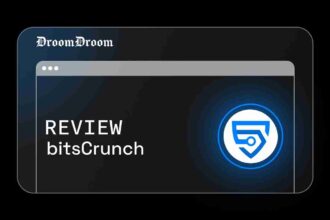Blockchain as we know it today is one of the world’s top tech trends. Like every business, there is a need to keep records of the transactions carried out, and we can do that using a ledger. The transactions that are carried out in the cryptospace are stored or registered in a blockchain. Blockchain is a digital collection of information about transactions.
In a nutshell, the Cosmos network connects blockchains via Hub allowing them to communicate with each other. Cosmos allows users to share data, assets, and validate transactions from blockchain to blockchain without a third party. This blockchain network runs on a Proof of Stake (POS) consensus algorithm, providing more security and scalability for its users.
Cosmos is basically an ordered system or a pattern. So we can say that the cosmos network is a system of blockchains. In this article, we are going to fully understand what the cosmos network in the cryptospace means and how it works. So sit back and buckle up and enjoy the ride.
Cosmos Network
Just like the name Cosmos, which simply means an order system or pattern. Just like in space, having its planets and stars in a pattern forming the solar system which forms the universe that also forms the multiverse, and so on, all these are in order or pattern. Here the Cosmos Network is a system or an internet of blockchains.
We all know that there is competition between blockchain users, majorly Bitcoin blockchain users, and Ethereum blockchain users, trying to out-rank each other and claim the throne as the king of blockchains. Cosmos Network allows blockchains to communicate, share data, and transact with each other. By allowing blockchains to interoperate, there is less of a need for these blockchains to compete with each other, thus no need for them to try to rule each other.
Individual blockchains don’t have to aim to become the picture, instead, each of them can represent a piece of a bigger picture based on whichever advantages it may have to offer. All this works based on a consensus mechanism called Tendermint. Tendermint can handle more than ten thousand (10,000) transactions per second.
Security in the cosmos network is very solid, even if many validator nodes end up offline or otherwise compromised there is a stop on how many validator nodes can exist, definitely a compromise in terms of decentralization.
Team Members and Background
Cosmos network was created by Jae Kwan in the year 2014. Jae Kwan is a software engineer and entrepreneur, he is the co-founder and CEO of Tendermint Int. Jae Kwan is responsible for leading the overall strategy and vision of the cosmos, he manages the day-to-day activities of the company. Kwan was later joined by Ethan Buchan, the co-founder and Chief Technical Officer of Tendermint Inc. Here is a brief history of the cosmos network;
2014
The first application of the Byzantine Fault Tolerance (BFT) in a “Proof of Stake” (POS) public blockchain context was carried out by Jae Kwan, in the same year he went on to found Tendermint (All in Bits Inc). Tendermint BFT is the most advanced implementation of the BFT consensus algorithm and Proof of Stake (POS) crypto economics to date. The project was launched with the intention of addressing scalability, speed, security, and other environmental issues associated with Bitcoin and Ethereum’s Proof of Work (POS), and it has proven to be up to the task ever since.
2015
Ethan Buchman joined forces with Jae Kwan to develop Tendermint. After the development of the Tendermint, All in Bits Inc joined hands with Monax to implement the EVM on top of Tendermint BFT (Ethermint 1.0). Tendermint is pluggable with applications written in any language via the Application Blockchain Interface (ABCI).
2016
During this period the co-founders of Tindermint published the white paper Cosmos: A Network of Distributed Ledgers. Cosmos won the Shanghai Blockchain Week “Most Innovative Project”. The Interchain Foundation (ICF) was later formed that year to support the development of Cosmos and the ecosystem that will contribute to the Cosmos Network. ICF contracts Tendermint to make Cosmos a reality.
2017
In 30 minutes the ICF raised $16.8M for the funding of the Cosmos Network, this was recorded as one of the most successful blockchain-based fundraising events in history. Application developers starts evaluating Cosmos as the platform to build their blockchain-based applications. During this period the early prototype of the Cosmos SDK started.
2018
Tendermint Inc. revolutionized the concept of Inter-Blockchain Communication (IBC), the cross-chain data passing mechanism for Cosmos, and they started the development specification. Cosmos Validators launched 20+ public testnets, and then after that Cosmos launched Game of Stakes, the first of its kind adversarial testnet developed with the largest network of 200+ consensus nodes ever to have run in a BFT environment.
2019+
Cosmos continues to gain traction with projects building on top of the SDK. Binance, the world’s largest cryptocurrency exchange, announces Binance Chain, which is built on Tendermint BFT and Cosmos SDK. The big bang: Cosmos Hub launched successfully on March 13th, 2019.
How Cosmos Network Works?
The cosmos network works based on a consensus mechanism called Tendermint. Tendermint is a blockchain protocol that is used to replicate and launch blockchain applications across machines in a secure and consistent manner. This allows developers to create a Proof of Stake (POS) blockchain that is fast, scalable, and secure.
Cosmos can connect Proof of Work (POW) and Proof of Stake (POS) blockchains through Zones and Hubs. Hubs represent blockchains that connect Zones, and when a Zone is connected to a Hub it automatically communicates with all the other Zones connected to the Hub. Zones are independent blockchains that can communicate with each other through a Hub. We can simply say that a Zone is a cosmos smart contract.
So let’s say you want to communicate or carry out a transaction between Bitcoin, Ethereum, and Binance smartchain all you need to do is connect to a cosmos Hub, and, behold you can now carry out your transactions and communicate with each other.
Atom
Cosmos has a native cryptocurrency just like a normal blockchain, and its native cryptocurrency is called ATOM. Atom makes it possible to stake, pay for transactions, be involved in the governance process, and so on. ATOM tokens are earned via staking and not mined, unlike blockchain. Cosmos (ATOM) has a market cap of over $3 billion USD and is ranked #25 among all cryptocurrencies by market cap.
Reasons behind the creation of the Cosmos Network
The Cosmos Network has been a great project over the years. Let us see its importance, thus knowing the reasons behind its creation.
Scalability
Using the Tendermint algorithm to carry out more than 10,000 transactions per second, scalability issues are resolved.
Security
Independent works of blockchains and keeping their sovereignty and security parameters which makes transactions more secure.
Interoperability
Cosmos Network uses Inter Blockchain Communication (IBC) protocol, which allows the interoperability between blockchain Zones. It allows blockchains to send tokens and share arbitrary data with each other.
Customizability
Cosmos network allows developers to create their own customized blockchain or build decentralized applications (DApps) using the Cosmos Software Development Kit (SDK).
Competition
The Cosmos Network was created to resolve scalability, security, speed, and other issues that are present in the Bitcoin and Ethereum networks. There are other platforms that have been launched over the past years to address these issues too. I’ll be listing and explaining a few other projects that serve as alternatives to the Cosmos Network;
Polkadot
Polkadot enables cross-blockchain transfer of any type of data or asset, and not just tokens. Polkadot allows users to interoperate with a wide variety of blockchains in the Polkadot Network. Polkadot blockchain has a native cryptocurrency known as DOT. The Polkadot blockchain is built on a Proof of Stake consensus mechanism.
Solana
Solana is a blockchain platform which uses a hybrid consensus mechanism. Solana is built on a Proof of History (POH) and Proof of Stake consensus mechanism to provide smart contract functionality, improving scalability and usability for its users. Because it runs on a hybrid consensus protocol, it save more time in the validation of transaction and smart contract execution. Solana has its native cryptocurrency which is SOL.
Cardano
Cardano is a blockchain platform that runs on a Proof of Stake (POS) consensus mechanism named Ouroboros. It facilitates transactions with its native cryptocurrency ADA. Because it runs on a Proof of Stake consensus mechanism, it uses far less energy than other platforms that are built on a Proof of Work (POW) consensus mechanism.
Future of Cosmos
There is a bright future for the Cosmos network alongside with its native cryptocurrency ATOM. Cosmos has been a successful project ever since its creation, with Binance building Binance chain on its Tendermint BFT and Cosmos SDK, not to mention dyDx which also integrated with the Cosmos network. Its native cryptocurrency Atom in the year 2023 was ranked #25 in the entire cryptoecosystem, upon battling other growing networks of its like. In September 2021 ATOM reached its all-time high (ATH) of $44.70. Wallet investors predict that by the year 2025 ATOm is expected to reach $24. With its massive potential for growth and adoption, Cosmos is expected to remain a major player in the cryptocurrency market in the long term.
Weaknesses
Cosmos faces a lot of serious and fast-growing competitors in the cryptoecosystem. Ethereum is top-notch and the ecosystem leader in DeFi, NFTs, DAOs, and more in the cryptoecosystem. Solana which was at a time second behind Ethereum as the largest NFT blockchain. Polkadot has also proven to be a worthy competitor in the ecosystem. Cardano is built on a different Proof of Stake consensus mechanism known as Ouroboros, and this blockchain network is often referred to as the “father of all Ethereum killers”. There are regulatory issues that need to be resolved in the Cosmos based on its Initial Coin Offering (ICO). With so many competitors in the ecosystem, Cosmos needs to top up its game in order not to be knocked out of the race.
Conclusion
With blockchain networks having some faults or we may say disadvantages like; scalability issues, slow transaction speed, dependence on internet connectivity, vulnerability to hacking and so many more. The Cosmos network was created to tackle these issues, and it has been doing a great job since its creation. Cosmos network provides more security, scalability, customizability, interoperability, etc. With all of this being said we all can agree that the Cosmos Network has made a positive impact in the blockchain industry. Read how
Frequently Asked Questions
What is the Cosmos blockchain network?
Cosmos blockchain network is referred to as the internet of blockchains. This blockchain ecosystem creates a network of connected blockchains allowing them to communicate with one another, sharing data, assets, and transacting with each other, without relying on a centralized server or a third party. Cosmos blockchain network was created to address scalability issues, security issues, interoperability, and other environmental issues associated with the Poof of Work (POW) in the blockchain ecosystem. The Cosmos blockchain network is built on a Proof of Stake (POS) consensus algorithm.
What is decentralization?
Decentralization is the transfer of control and decision-making from a centralized entity to a distributed network of participants. In the blockchain, this helps improve transparency, efficiency, and security of the network.
What is proof of stake?
Proof of stake is a type of consensus protocol for blockchains that works by selecting validators in proportion to their quantity of holdings in the associated cryptocurrency. This is designed to prevent fraud, stopping users from printing extra coins they didn’t earn by paying users to vouch for the legitimacy of transactions.




















